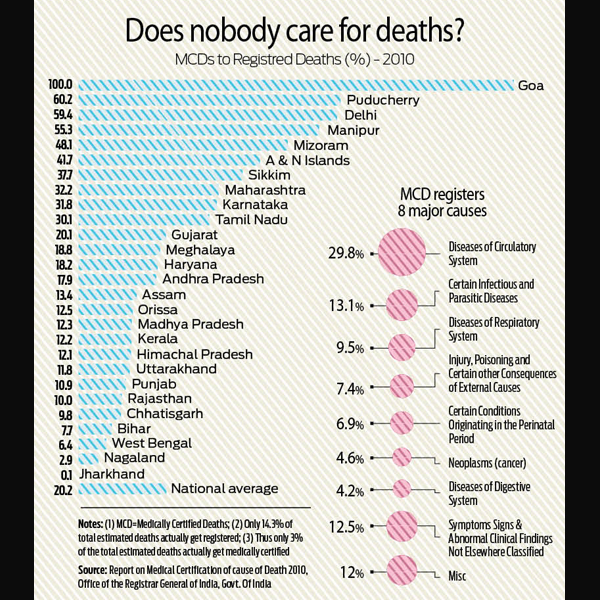The government is keen on strengthening Aadhaar. That will allow it to effectively implement its Direct Benefits Transfer (DBT) programme across the country.
But there is a gaping hole in the entire process. India has been counting only its living. It has ignored many of its dead. This is extremely serious because it can lead to a variety of major headaches.
In fact, few have paid heed to this problem — at least till August last year. That was when RK Gautam, Deputy Registrar General, Office of the Registrar General of India, Ministry of Home Affairs, Government of India, formally raised this issue.
In his communication dated August 28, 2014, he flagged the urgent need to extend the scheme of medical certification of cause of death (MCCD) to all medical institutions. He pointed out that the MCCD — which falls under the purview of the Registration of Births and Deaths Act (RBD Act), 1969 — needs an urgent re-look. He wrote that “the data on cause-specific mortality generated under the scheme suffers on account of reliability, representativeness and comparability…”
He also recorded “the present coverage to medically certified deaths to the total registered deaths is 20.2% and only 14.3% against the total estimated deaths.” Unfortunately little clarity is provided by the Registrar of Births and Deaths (RBD).
However, some figures can be got from Census reports. Data from Table 2.4 of the 2010 Census Report on MCCD shows the total number of registered deaths to be 4.66 million, 4.76 million and 4.82 million for the years 2008, 2009 and 2010 respectively. UNICEF’ believes that around 9 million people die annually in India (http://unicef.in/Story/1133/Birth-Registration-the-picture-in-India). This means that almost 50% of deaths go unregistered. Of these, only 20% get medically certified. That translates into just 10% of the dying population in this country getting medically certified.
This has several implications.
First, the cavalier manner in which the government machinery has treated deaths leaves open a very wide gap for identity theft and impersonation. If the dead are not properly recorded, anyone can steal the identity of a person whose birth and living records exist (remember how it was done in the novel The Day of the Jackal?). That is a big security risk. It is also a big financial risk, especially since Aadhaar is meant to reduce the number of ghost recipients of government doles.
Second, take a look at the classification of the causes of death (see chart). There is no mention of death by starvation or even malnutrition. So were these cases registered as death on account of “natural causes”? Had the cause of death been recorded honestly, someone could have sued the government or even the district collector concerned. Clearly, for almost 45 years, the Indian government has been foisting a deception on its own people, and even to data enumerators of the United Nations.
Third, the meagre number of MCCD records suggests that crimes against weaker sections of society could be far more widespread than is currently assumed. Since there is nobody around to register and medically certify the cause of death, eliminating a trouble-maker in remote parts of India can be a very convenient matter.
All these possibilities are terribly unsettling. What is heartening is that the present government has taken cognizance of this major flaw, and has now instructed the RBD to issue necessary directions (under Section 4 (4) of the RBD Act) to ensure complete coverage.
The Registrar has been asked to prepare an up-to-date list of all government, private and non-profit-making medical institutions covered under this scheme and obtain a monthly return of deaths from each one of them, and to undertake periodic inspections to monitor the quality of MCCD data.
It is surprising that none of the previous governments bothered to do this for almost 45 years. This was abetted and compounded by state governments — most did not even bother to get even half the registered deaths medically certified.
Was it callousness, or deviousness (in order to promote more ghost claimants of government largesse)? Expect more skeletons to come tumbling out of closets (pun regretted), as data on the national fudge in the country begins to get compiled and the rot exposed. For now, the only silver lining is that the alarm bells have finally started to ring.
Unfortunately, this is not the first time the government has tried to fudge data. Take the manner in which literacy has been sought to be measured. The acid test adopted is whether people know to read and write their names.
Thus if Ram knows how to write and read just the three letters of his name, he is counted as being literate. That is how the government sought to make the nation’s statistical data on literacy look good.
Then, look at what Kapil Sibal (former Union minister of Human Resource Development) did with his “Right to Education Act (RTE)” (http://dnai.in/97TH). He made promotions compulsory and automatic till Std VIII. This would allow Secondary School enrolment to swell (though this did not happen — http://dnai.in/cNFc and http://dnai.in/cMZs), thus telling the world that India had improved its access to education. In reality, the RTE has corroded the fabric of education in India more savagely than ever before.
Sadly, such deceptions are disastrous for planning growth, and for spending. This needs to stop. India cannot aspire to become a global player if its basic numbers are flawed.






































COMMENTS